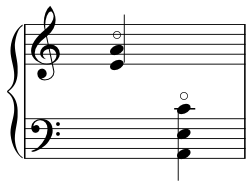Harmonics in combination with normal notes
Harmonic and normal notes in different hands
Using harmonics in combination with normal notes is a popular and effective color effect in the harp repertoire. Combining harmonics in one hand with normal notes in the other causes no notational problems. It is important to keep in mind that a harmonic and a normal note cannot be played on the same string simultaneously.
Harmonic and normal note in the same hand
It is possible to play a harmonic and normal notes simultaneously in one hand. However, due to different hand positions while producing the harmonic, the right and the left hand produce harmonics combined with normal notes differently.
Production, left hand
The left hand can combine a harmonic and up to three normal notes within the normal reach of the hand. The harmonic must, however, be the highest note of the chord or interval. Note that the harpist will play the chord or interval as an arpeggio. This is because the left hand requires a different hand position for playing normal notes and for playing harmonics. After playing the normal notes the harpist quickly turns the hand in order to stop the string with the base of the hand to produce the harmonic.
Production, right hand
The right hand can combine a harmonic and up to two normal notes within the reach of five strings. The harmonic must be at the top of the interval or chord. The thumb and the second finger produce the harmonic in the regular way while the third or fourth finger plays the lower note/notes.
Notation
A single harmonic sign above a chord or an interval indicates that only the top note of the interval should be played as a harmonic.

A harmonic combined with normal notes.
Range
The harmonic should be within the relevant range for harmonics, i.e. an octave harmonic within the range for octave harmonics etc.